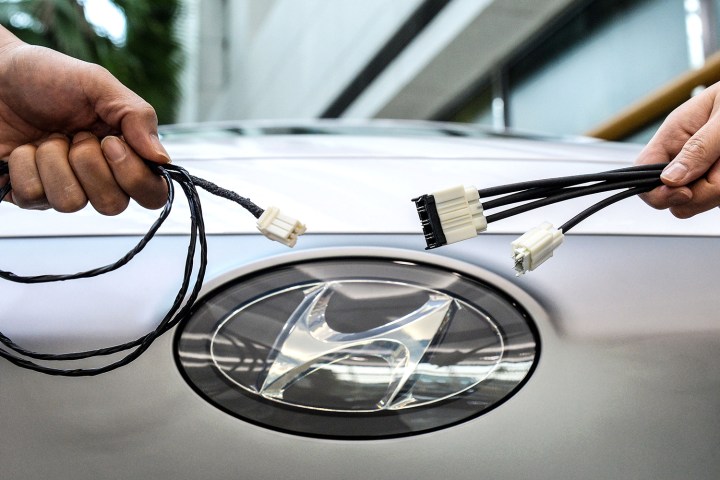
“It’s probably one of the biggest opportunities on the face of the planet.”
Four years later, you can count on one hand the number of car companies that are even close to similar capabilities: Ford upgraded its infotainment system remotely last year, a related technology on a far-less-important scale. GM plans over-the-air (OTA) updates for 2020.
Until now.
On Tuesday at CES 2018, Hyundai and Cisco revealed a new technology road map to completely reinvent in-vehicle networking, bringing fast and reliable Ethernet connectivity, the Automotive Linux platform, and the ability to roll out new features throughout the vehicle at the push of a button. Both companies say the technology paves the way for autonomous driving in the future. Similar collaborations between technology and automotive companies are being announced throughout the technology show – and it’s heralding an opportunity that will transform the car as we know it.

“It’s probably one of the biggest opportunities on the face of the planet,” James Peters, Connected Car vice president for Cisco, told Digital Trends. “Think about merging Silicon Valley and Detroit. It’d be a game changer for the automotive industry.”
Meet the hyperconnected car
The first fruits of are the new platform for “the next generation of hyperconnected car” that the two companies have unveiled. It replaces some of the complex and weighty spaghetti mess of wires found in current vehicles (something called a CAN, or Controller Area Network) with a vastly simpler one based around 1-Gbps Ethernet, the same stuff you plug into your computer or your router. Replacing wires isn’t just small potatoes. The miles of wiring in a car’s wiring harness adds not just complexity and cost but also weight, as much as a hundred pounds. One company Cisco spoke with thought it might be able to add a mile per gallon to fuel economy stats with the system.
It’s the first step toward throwing out the legacy mess of wires in most cars and moving them toward the simpler system in vehicles like Tesla’s – but cleanup and simplicity aren’t the goals here.
“The main purpose is not to reduce the weight of the wiring harness itself. That’s a byproduct. The main purpose is to get those automobiles ready for new services in the future,” explained Seung-ho Hwang, executive vice president and head of Hyundai Motor Group’s Auto Intelligence Business Department.
Buy the hyperconnected car Hyundai’s Genesis brand will roll out in late 2019, and it won’t be able to patch the brakes if a flaw is found in a controller, nor will it add plaid mode (or even ludicrous mode). But it will make video feeds from the backup cameras and blind-spot monitoring cameras more accessible to the driver. It will also offer OTA updates to the infotainment system, and down the road – well, the potential is enormous. Think of it as future-proofing.
Future proofing (while keeping it secure)
“It’s preparation for the connected car. Connected-car services — remote maintenance, diagnosis, and even repair, and more intelligent navigation,” Hwang told Digital Trends. Many of those services rely not on bandwidth in the car but out of the car, he said, and updating the vehicle is necessary nonetheless. To that end, Cisco has built a central gateway for the car, just like your router in essence, which connects to the legacy networks in your car and to the “head unit,” auto-speak for the infotainment system on your dash.
Taking a gamble that may brick 8 million vehicles is something Hyundai is reluctant to do.
“You’ve got a lot of low-speed, low-security networks in cars today. Most of them are closed networks,” Peters explained. Cisco wants to replace that with modern, secure networking based on the tools it has spent decades building and honing. And because of that expertise, and software that connects to some of the legacy networking, Cisco can update, say, the backup camera if need be.
“We’re able to open up a connection to a camera, download some new software, and then close it up again,” Peters said. Just like Tesla’s vehicles can. Cisco also brings decades of security expertise, and the new network is no different, offering multilayer security: link-layer encryption, prescriptive white lists, firewalling, and other safety mumbo jumbo.
So it’ll be just like Tesla, right? Well … sort of.
While updating a few thousand or even tens of thousands of Teslas is risky, taking a gamble that may brick 8 million vehicles is something Hyundai is more reluctant to do. So Hyundai will start with convenience features, Hwang explained, such as infotainment system updates. Safety updates will be more serious. And safety is baked into the very design of the car, explained Luc Donckerwolke, executive vice president of Hyundai Design Center.
“The fact that all electronic devices can hear – are hearing — everything we say, and all the devices are able to see us, hear us, and interact with us,” Donckerwolke said. “We have to think about all that as designer … it’s a question we have to address.”


